Corporate Accounting: Regulations, Standards, Equity of Mining Firms
VerifiedAdded on 2023/06/05
|16
|2923
|200
Report
AI Summary
This report provides an analysis of corporate accounting regulations, accounting standard settings, and owner’s equity within the context of the Australian mining industry. It discusses the importance of proper financial reporting and disclosure, highlighting the roles of IFRS and AASB standards. The report examines key components of owner's equity, including retained earnings, contributed equity, and various reserves, and their impact on financial statements. A comparative analysis of BHP Billiton, Rio Tinto, Fortescue Metals Group, and Orica Limited is presented, focusing on their equity components and financial performance. The report also touches on the evaluation of debt and equity, aiming to provide insights into the financial health and reporting practices of these companies. Desklib provides a platform to explore similar solved assignments.
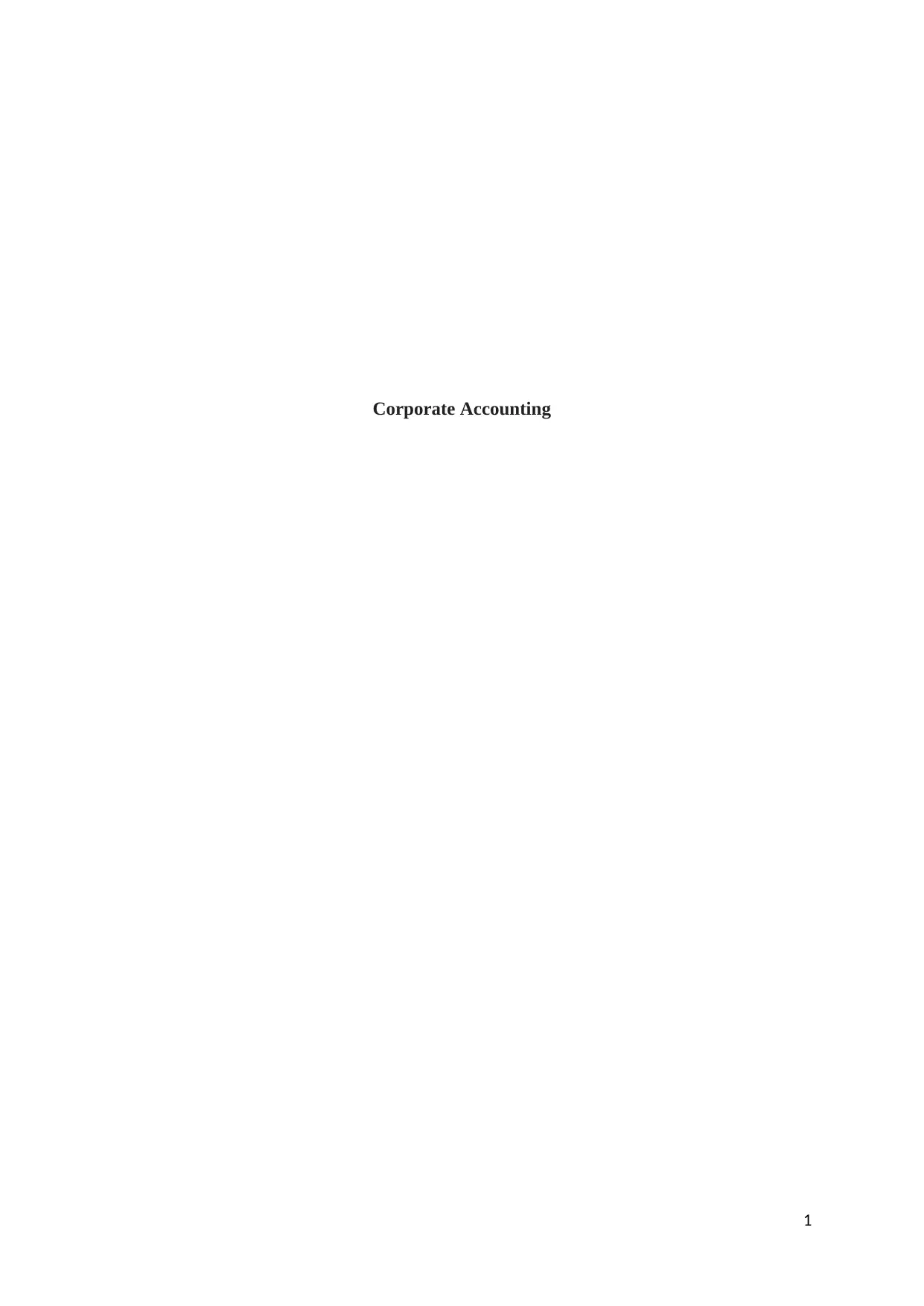
Corporate Accounting
1
1
Paraphrase This Document
Need a fresh take? Get an instant paraphrase of this document with our AI Paraphraser
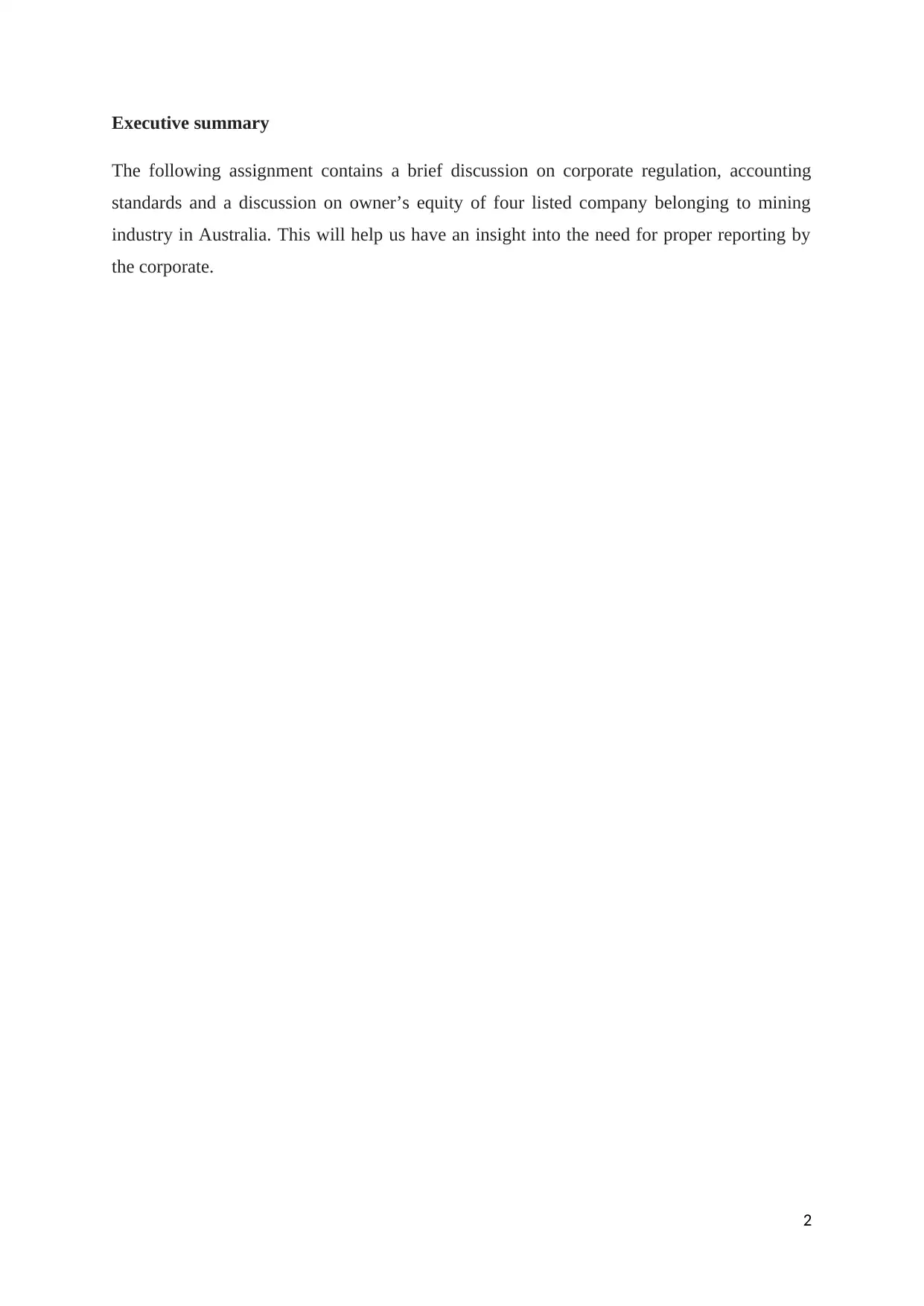
Executive summary
The following assignment contains a brief discussion on corporate regulation, accounting
standards and a discussion on owner’s equity of four listed company belonging to mining
industry in Australia. This will help us have an insight into the need for proper reporting by
the corporate.
2
The following assignment contains a brief discussion on corporate regulation, accounting
standards and a discussion on owner’s equity of four listed company belonging to mining
industry in Australia. This will help us have an insight into the need for proper reporting by
the corporate.
2
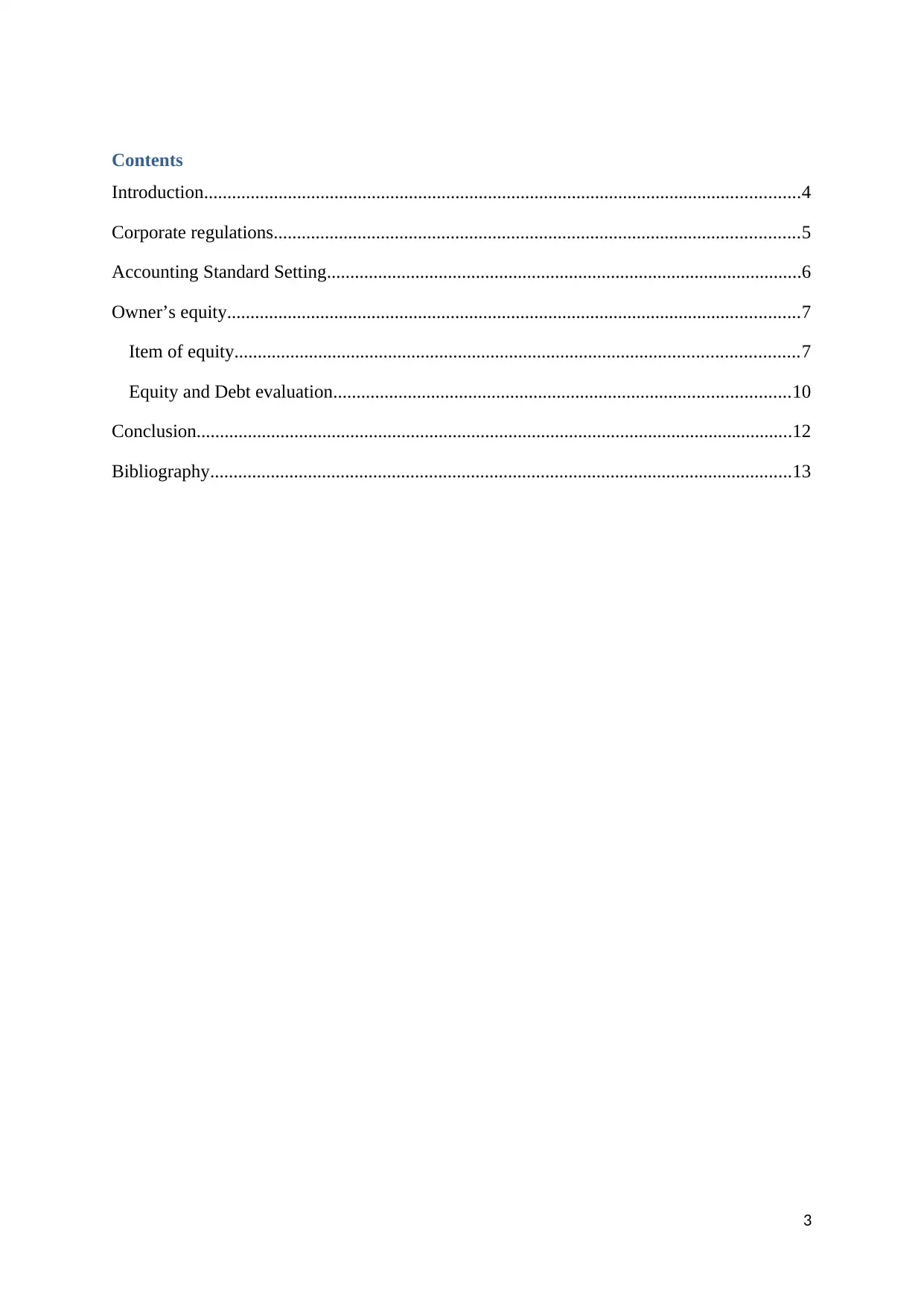
Contents
Introduction................................................................................................................................4
Corporate regulations.................................................................................................................5
Accounting Standard Setting......................................................................................................6
Owner’s equity...........................................................................................................................7
Item of equity.........................................................................................................................7
Equity and Debt evaluation..................................................................................................10
Conclusion................................................................................................................................12
Bibliography.............................................................................................................................13
3
Introduction................................................................................................................................4
Corporate regulations.................................................................................................................5
Accounting Standard Setting......................................................................................................6
Owner’s equity...........................................................................................................................7
Item of equity.........................................................................................................................7
Equity and Debt evaluation..................................................................................................10
Conclusion................................................................................................................................12
Bibliography.............................................................................................................................13
3
⊘ This is a preview!⊘
Do you want full access?
Subscribe today to unlock all pages.

Trusted by 1+ million students worldwide
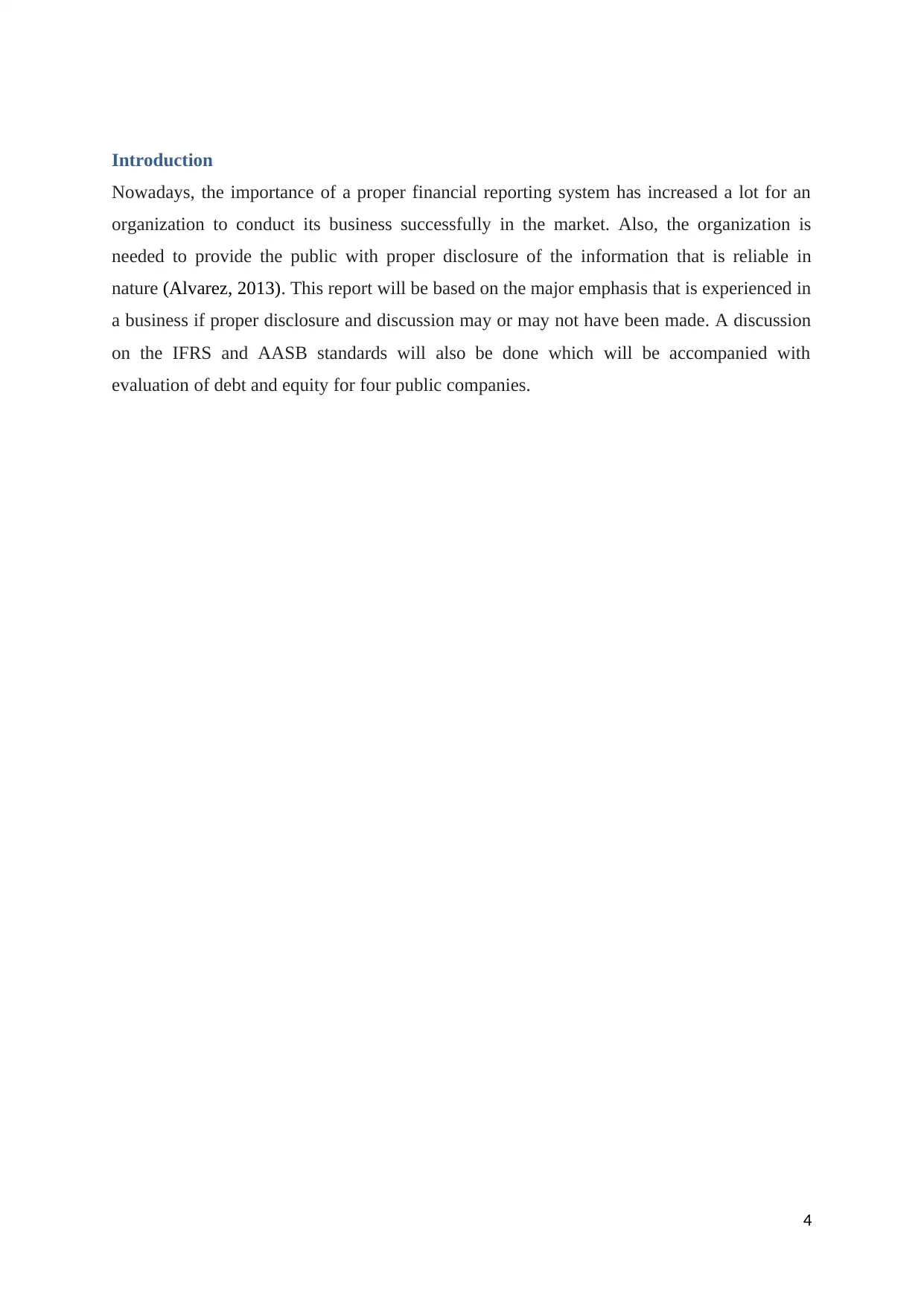
Introduction
Nowadays, the importance of a proper financial reporting system has increased a lot for an
organization to conduct its business successfully in the market. Also, the organization is
needed to provide the public with proper disclosure of the information that is reliable in
nature (Alvarez, 2013). This report will be based on the major emphasis that is experienced in
a business if proper disclosure and discussion may or may not have been made. A discussion
on the IFRS and AASB standards will also be done which will be accompanied with
evaluation of debt and equity for four public companies.
4
Nowadays, the importance of a proper financial reporting system has increased a lot for an
organization to conduct its business successfully in the market. Also, the organization is
needed to provide the public with proper disclosure of the information that is reliable in
nature (Alvarez, 2013). This report will be based on the major emphasis that is experienced in
a business if proper disclosure and discussion may or may not have been made. A discussion
on the IFRS and AASB standards will also be done which will be accompanied with
evaluation of debt and equity for four public companies.
4
Paraphrase This Document
Need a fresh take? Get an instant paraphrase of this document with our AI Paraphraser
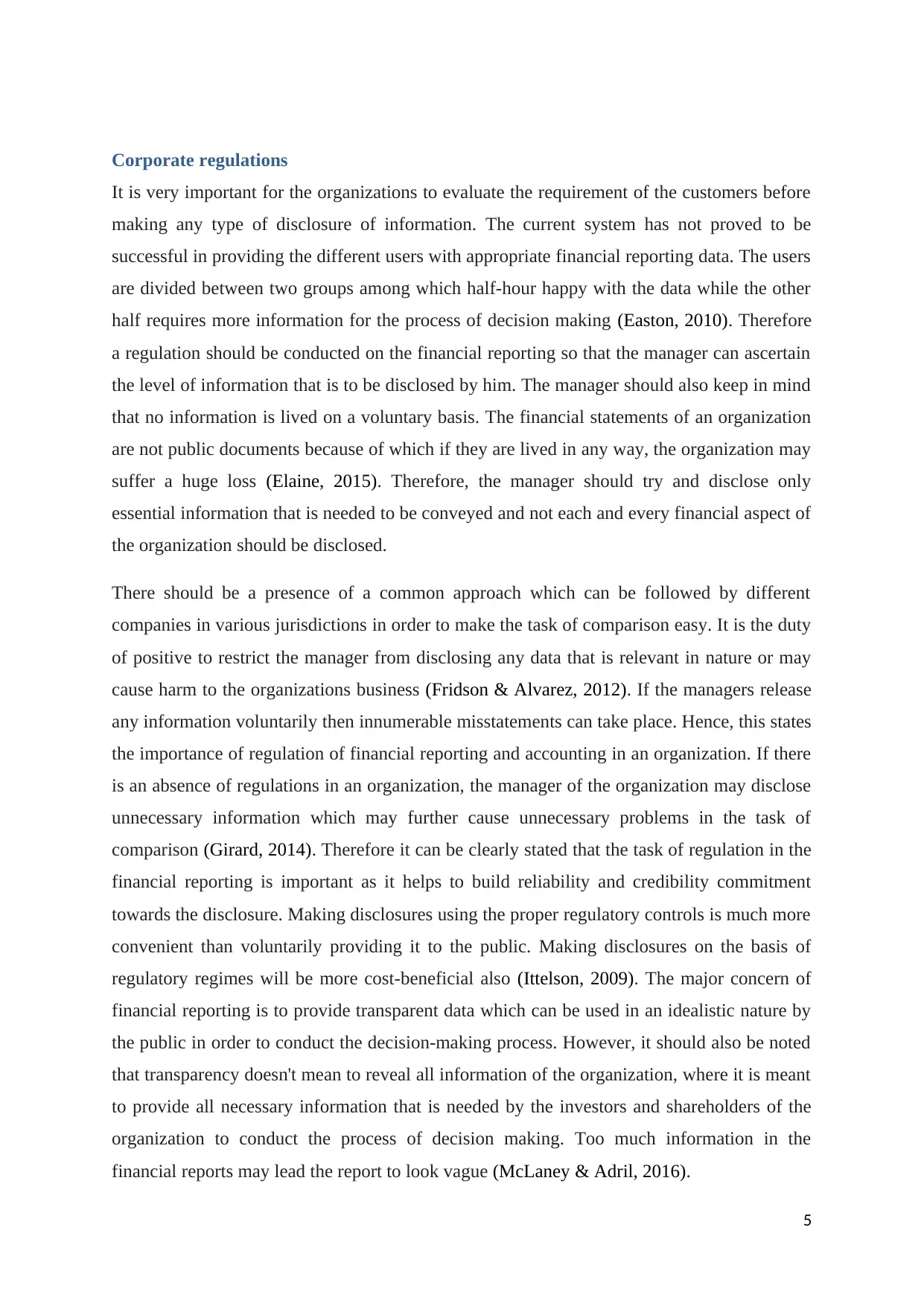
Corporate regulations
It is very important for the organizations to evaluate the requirement of the customers before
making any type of disclosure of information. The current system has not proved to be
successful in providing the different users with appropriate financial reporting data. The users
are divided between two groups among which half-hour happy with the data while the other
half requires more information for the process of decision making (Easton, 2010). Therefore
a regulation should be conducted on the financial reporting so that the manager can ascertain
the level of information that is to be disclosed by him. The manager should also keep in mind
that no information is lived on a voluntary basis. The financial statements of an organization
are not public documents because of which if they are lived in any way, the organization may
suffer a huge loss (Elaine, 2015). Therefore, the manager should try and disclose only
essential information that is needed to be conveyed and not each and every financial aspect of
the organization should be disclosed.
There should be a presence of a common approach which can be followed by different
companies in various jurisdictions in order to make the task of comparison easy. It is the duty
of positive to restrict the manager from disclosing any data that is relevant in nature or may
cause harm to the organizations business (Fridson & Alvarez, 2012). If the managers release
any information voluntarily then innumerable misstatements can take place. Hence, this states
the importance of regulation of financial reporting and accounting in an organization. If there
is an absence of regulations in an organization, the manager of the organization may disclose
unnecessary information which may further cause unnecessary problems in the task of
comparison (Girard, 2014). Therefore it can be clearly stated that the task of regulation in the
financial reporting is important as it helps to build reliability and credibility commitment
towards the disclosure. Making disclosures using the proper regulatory controls is much more
convenient than voluntarily providing it to the public. Making disclosures on the basis of
regulatory regimes will be more cost-beneficial also (Ittelson, 2009). The major concern of
financial reporting is to provide transparent data which can be used in an idealistic nature by
the public in order to conduct the decision-making process. However, it should also be noted
that transparency doesn't mean to reveal all information of the organization, where it is meant
to provide all necessary information that is needed by the investors and shareholders of the
organization to conduct the process of decision making. Too much information in the
financial reports may lead the report to look vague (McLaney & Adril, 2016).
5
It is very important for the organizations to evaluate the requirement of the customers before
making any type of disclosure of information. The current system has not proved to be
successful in providing the different users with appropriate financial reporting data. The users
are divided between two groups among which half-hour happy with the data while the other
half requires more information for the process of decision making (Easton, 2010). Therefore
a regulation should be conducted on the financial reporting so that the manager can ascertain
the level of information that is to be disclosed by him. The manager should also keep in mind
that no information is lived on a voluntary basis. The financial statements of an organization
are not public documents because of which if they are lived in any way, the organization may
suffer a huge loss (Elaine, 2015). Therefore, the manager should try and disclose only
essential information that is needed to be conveyed and not each and every financial aspect of
the organization should be disclosed.
There should be a presence of a common approach which can be followed by different
companies in various jurisdictions in order to make the task of comparison easy. It is the duty
of positive to restrict the manager from disclosing any data that is relevant in nature or may
cause harm to the organizations business (Fridson & Alvarez, 2012). If the managers release
any information voluntarily then innumerable misstatements can take place. Hence, this states
the importance of regulation of financial reporting and accounting in an organization. If there
is an absence of regulations in an organization, the manager of the organization may disclose
unnecessary information which may further cause unnecessary problems in the task of
comparison (Girard, 2014). Therefore it can be clearly stated that the task of regulation in the
financial reporting is important as it helps to build reliability and credibility commitment
towards the disclosure. Making disclosures using the proper regulatory controls is much more
convenient than voluntarily providing it to the public. Making disclosures on the basis of
regulatory regimes will be more cost-beneficial also (Ittelson, 2009). The major concern of
financial reporting is to provide transparent data which can be used in an idealistic nature by
the public in order to conduct the decision-making process. However, it should also be noted
that transparency doesn't mean to reveal all information of the organization, where it is meant
to provide all necessary information that is needed by the investors and shareholders of the
organization to conduct the process of decision making. Too much information in the
financial reports may lead the report to look vague (McLaney & Adril, 2016).
5

6
⊘ This is a preview!⊘
Do you want full access?
Subscribe today to unlock all pages.

Trusted by 1+ million students worldwide
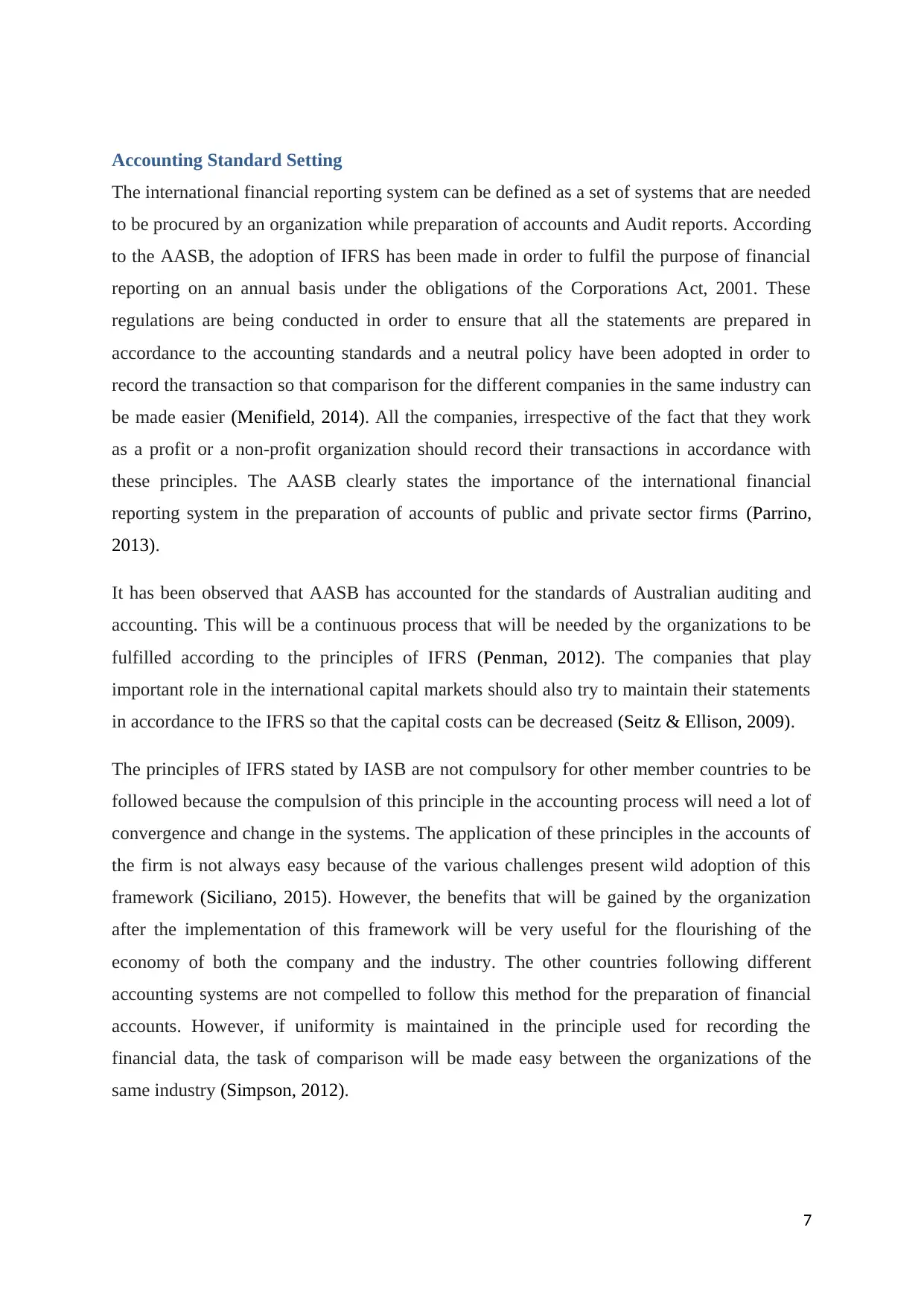
Accounting Standard Setting
The international financial reporting system can be defined as a set of systems that are needed
to be procured by an organization while preparation of accounts and Audit reports. According
to the AASB, the adoption of IFRS has been made in order to fulfil the purpose of financial
reporting on an annual basis under the obligations of the Corporations Act, 2001. These
regulations are being conducted in order to ensure that all the statements are prepared in
accordance to the accounting standards and a neutral policy have been adopted in order to
record the transaction so that comparison for the different companies in the same industry can
be made easier (Menifield, 2014). All the companies, irrespective of the fact that they work
as a profit or a non-profit organization should record their transactions in accordance with
these principles. The AASB clearly states the importance of the international financial
reporting system in the preparation of accounts of public and private sector firms (Parrino,
2013).
It has been observed that AASB has accounted for the standards of Australian auditing and
accounting. This will be a continuous process that will be needed by the organizations to be
fulfilled according to the principles of IFRS (Penman, 2012). The companies that play
important role in the international capital markets should also try to maintain their statements
in accordance to the IFRS so that the capital costs can be decreased (Seitz & Ellison, 2009).
The principles of IFRS stated by IASB are not compulsory for other member countries to be
followed because the compulsion of this principle in the accounting process will need a lot of
convergence and change in the systems. The application of these principles in the accounts of
the firm is not always easy because of the various challenges present wild adoption of this
framework (Siciliano, 2015). However, the benefits that will be gained by the organization
after the implementation of this framework will be very useful for the flourishing of the
economy of both the company and the industry. The other countries following different
accounting systems are not compelled to follow this method for the preparation of financial
accounts. However, if uniformity is maintained in the principle used for recording the
financial data, the task of comparison will be made easy between the organizations of the
same industry (Simpson, 2012).
7
The international financial reporting system can be defined as a set of systems that are needed
to be procured by an organization while preparation of accounts and Audit reports. According
to the AASB, the adoption of IFRS has been made in order to fulfil the purpose of financial
reporting on an annual basis under the obligations of the Corporations Act, 2001. These
regulations are being conducted in order to ensure that all the statements are prepared in
accordance to the accounting standards and a neutral policy have been adopted in order to
record the transaction so that comparison for the different companies in the same industry can
be made easier (Menifield, 2014). All the companies, irrespective of the fact that they work
as a profit or a non-profit organization should record their transactions in accordance with
these principles. The AASB clearly states the importance of the international financial
reporting system in the preparation of accounts of public and private sector firms (Parrino,
2013).
It has been observed that AASB has accounted for the standards of Australian auditing and
accounting. This will be a continuous process that will be needed by the organizations to be
fulfilled according to the principles of IFRS (Penman, 2012). The companies that play
important role in the international capital markets should also try to maintain their statements
in accordance to the IFRS so that the capital costs can be decreased (Seitz & Ellison, 2009).
The principles of IFRS stated by IASB are not compulsory for other member countries to be
followed because the compulsion of this principle in the accounting process will need a lot of
convergence and change in the systems. The application of these principles in the accounts of
the firm is not always easy because of the various challenges present wild adoption of this
framework (Siciliano, 2015). However, the benefits that will be gained by the organization
after the implementation of this framework will be very useful for the flourishing of the
economy of both the company and the industry. The other countries following different
accounting systems are not compelled to follow this method for the preparation of financial
accounts. However, if uniformity is maintained in the principle used for recording the
financial data, the task of comparison will be made easy between the organizations of the
same industry (Simpson, 2012).
7
Paraphrase This Document
Need a fresh take? Get an instant paraphrase of this document with our AI Paraphraser

8
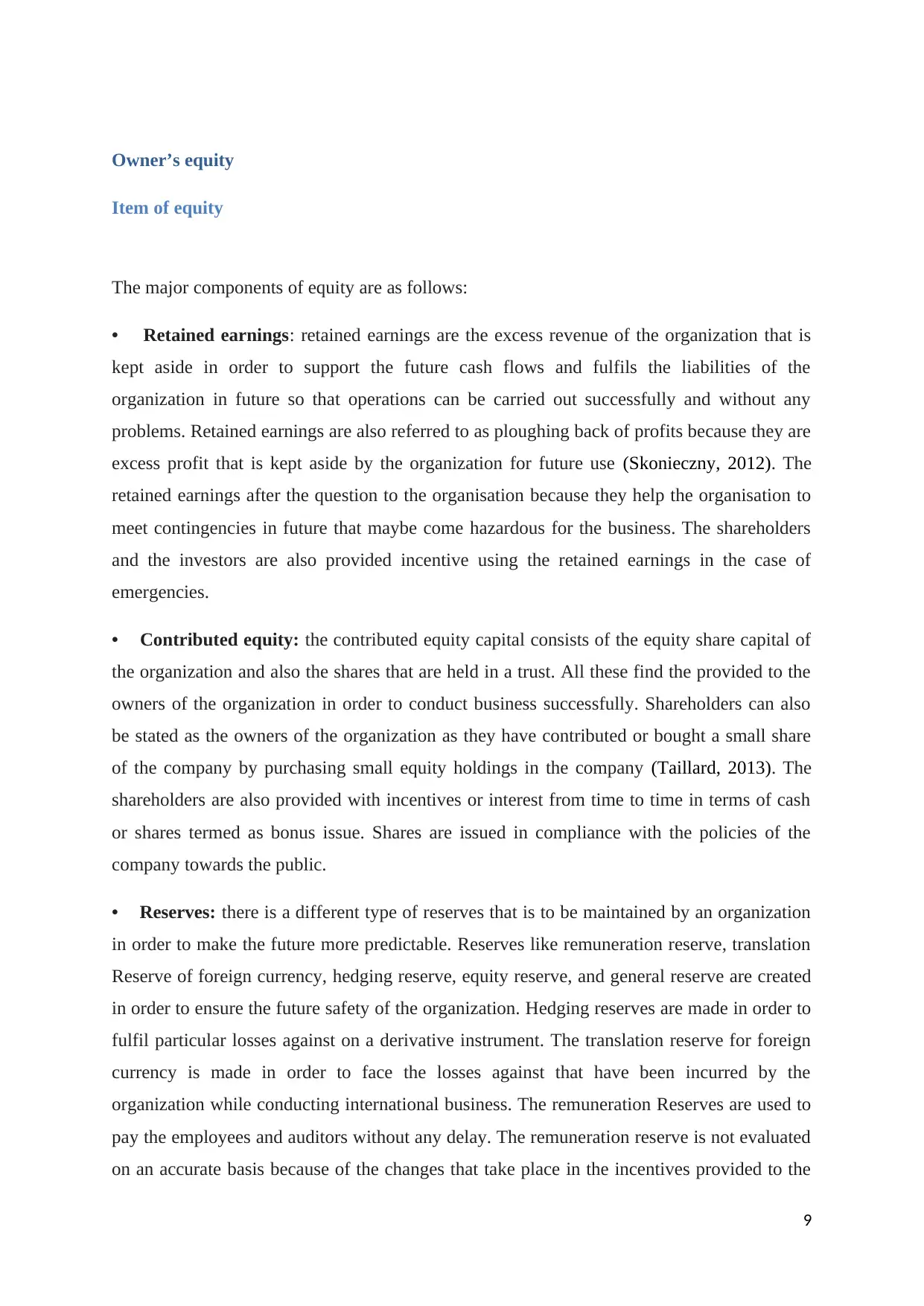
Owner’s equity
Item of equity
The major components of equity are as follows:
• Retained earnings: retained earnings are the excess revenue of the organization that is
kept aside in order to support the future cash flows and fulfils the liabilities of the
organization in future so that operations can be carried out successfully and without any
problems. Retained earnings are also referred to as ploughing back of profits because they are
excess profit that is kept aside by the organization for future use (Skonieczny, 2012). The
retained earnings after the question to the organisation because they help the organisation to
meet contingencies in future that maybe come hazardous for the business. The shareholders
and the investors are also provided incentive using the retained earnings in the case of
emergencies.
• Contributed equity: the contributed equity capital consists of the equity share capital of
the organization and also the shares that are held in a trust. All these find the provided to the
owners of the organization in order to conduct business successfully. Shareholders can also
be stated as the owners of the organization as they have contributed or bought a small share
of the company by purchasing small equity holdings in the company (Taillard, 2013). The
shareholders are also provided with incentives or interest from time to time in terms of cash
or shares termed as bonus issue. Shares are issued in compliance with the policies of the
company towards the public.
• Reserves: there is a different type of reserves that is to be maintained by an organization
in order to make the future more predictable. Reserves like remuneration reserve, translation
Reserve of foreign currency, hedging reserve, equity reserve, and general reserve are created
in order to ensure the future safety of the organization. Hedging reserves are made in order to
fulfil particular losses against on a derivative instrument. The translation reserve for foreign
currency is made in order to face the losses against that have been incurred by the
organization while conducting international business. The remuneration Reserves are used to
pay the employees and auditors without any delay. The remuneration reserve is not evaluated
on an accurate basis because of the changes that take place in the incentives provided to the
9
Item of equity
The major components of equity are as follows:
• Retained earnings: retained earnings are the excess revenue of the organization that is
kept aside in order to support the future cash flows and fulfils the liabilities of the
organization in future so that operations can be carried out successfully and without any
problems. Retained earnings are also referred to as ploughing back of profits because they are
excess profit that is kept aside by the organization for future use (Skonieczny, 2012). The
retained earnings after the question to the organisation because they help the organisation to
meet contingencies in future that maybe come hazardous for the business. The shareholders
and the investors are also provided incentive using the retained earnings in the case of
emergencies.
• Contributed equity: the contributed equity capital consists of the equity share capital of
the organization and also the shares that are held in a trust. All these find the provided to the
owners of the organization in order to conduct business successfully. Shareholders can also
be stated as the owners of the organization as they have contributed or bought a small share
of the company by purchasing small equity holdings in the company (Taillard, 2013). The
shareholders are also provided with incentives or interest from time to time in terms of cash
or shares termed as bonus issue. Shares are issued in compliance with the policies of the
company towards the public.
• Reserves: there is a different type of reserves that is to be maintained by an organization
in order to make the future more predictable. Reserves like remuneration reserve, translation
Reserve of foreign currency, hedging reserve, equity reserve, and general reserve are created
in order to ensure the future safety of the organization. Hedging reserves are made in order to
fulfil particular losses against on a derivative instrument. The translation reserve for foreign
currency is made in order to face the losses against that have been incurred by the
organization while conducting international business. The remuneration Reserves are used to
pay the employees and auditors without any delay. The remuneration reserve is not evaluated
on an accurate basis because of the changes that take place in the incentives provided to the
9
⊘ This is a preview!⊘
Do you want full access?
Subscribe today to unlock all pages.

Trusted by 1+ million students worldwide
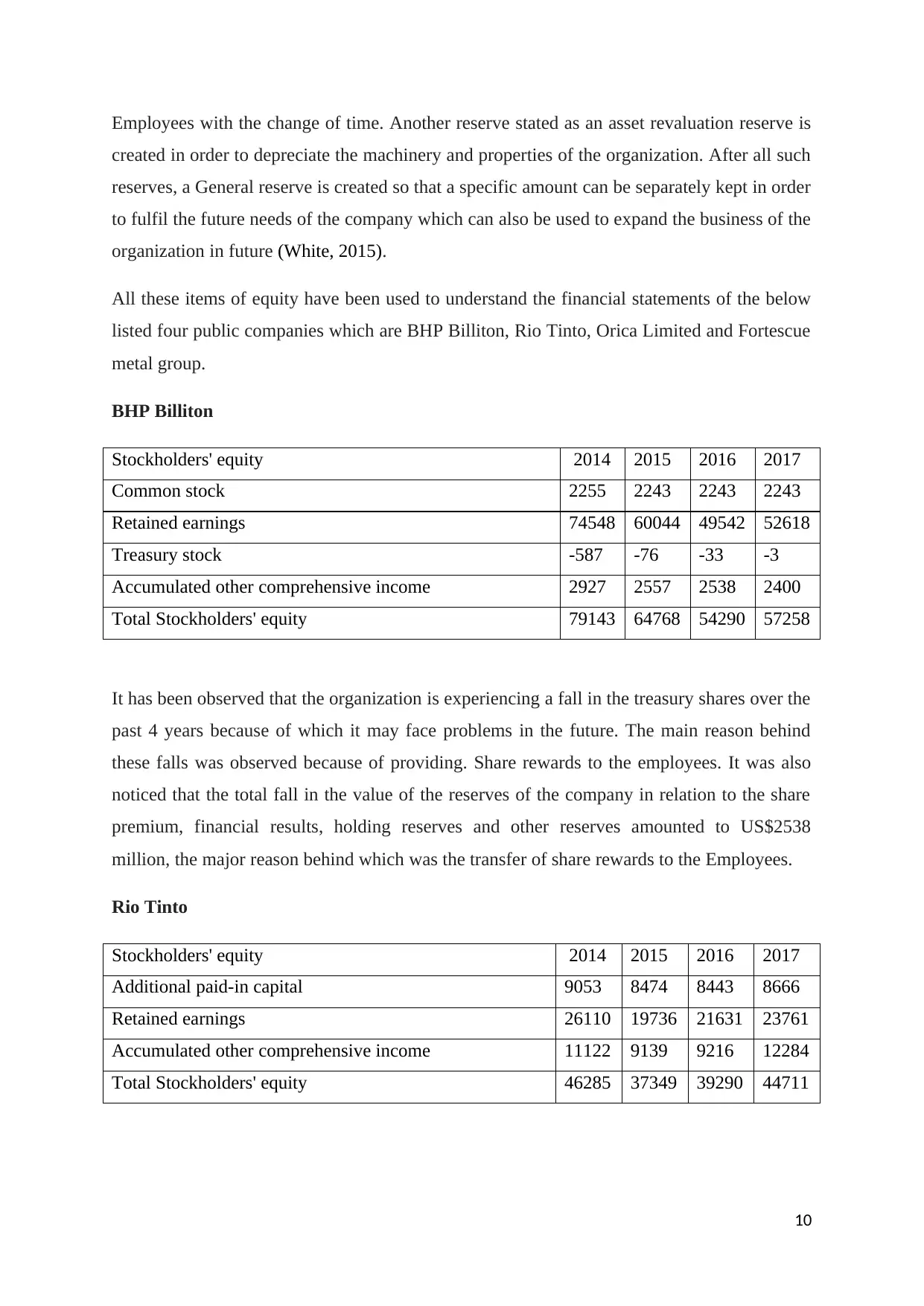
Employees with the change of time. Another reserve stated as an asset revaluation reserve is
created in order to depreciate the machinery and properties of the organization. After all such
reserves, a General reserve is created so that a specific amount can be separately kept in order
to fulfil the future needs of the company which can also be used to expand the business of the
organization in future (White, 2015).
All these items of equity have been used to understand the financial statements of the below
listed four public companies which are BHP Billiton, Rio Tinto, Orica Limited and Fortescue
metal group.
BHP Billiton
Stockholders' equity 2014 2015 2016 2017
Common stock 2255 2243 2243 2243
Retained earnings 74548 60044 49542 52618
Treasury stock -587 -76 -33 -3
Accumulated other comprehensive income 2927 2557 2538 2400
Total Stockholders' equity 79143 64768 54290 57258
It has been observed that the organization is experiencing a fall in the treasury shares over the
past 4 years because of which it may face problems in the future. The main reason behind
these falls was observed because of providing. Share rewards to the employees. It was also
noticed that the total fall in the value of the reserves of the company in relation to the share
premium, financial results, holding reserves and other reserves amounted to US$2538
million, the major reason behind which was the transfer of share rewards to the Employees.
Rio Tinto
Stockholders' equity 2014 2015 2016 2017
Additional paid-in capital 9053 8474 8443 8666
Retained earnings 26110 19736 21631 23761
Accumulated other comprehensive income 11122 9139 9216 12284
Total Stockholders' equity 46285 37349 39290 44711
10
created in order to depreciate the machinery and properties of the organization. After all such
reserves, a General reserve is created so that a specific amount can be separately kept in order
to fulfil the future needs of the company which can also be used to expand the business of the
organization in future (White, 2015).
All these items of equity have been used to understand the financial statements of the below
listed four public companies which are BHP Billiton, Rio Tinto, Orica Limited and Fortescue
metal group.
BHP Billiton
Stockholders' equity 2014 2015 2016 2017
Common stock 2255 2243 2243 2243
Retained earnings 74548 60044 49542 52618
Treasury stock -587 -76 -33 -3
Accumulated other comprehensive income 2927 2557 2538 2400
Total Stockholders' equity 79143 64768 54290 57258
It has been observed that the organization is experiencing a fall in the treasury shares over the
past 4 years because of which it may face problems in the future. The main reason behind
these falls was observed because of providing. Share rewards to the employees. It was also
noticed that the total fall in the value of the reserves of the company in relation to the share
premium, financial results, holding reserves and other reserves amounted to US$2538
million, the major reason behind which was the transfer of share rewards to the Employees.
Rio Tinto
Stockholders' equity 2014 2015 2016 2017
Additional paid-in capital 9053 8474 8443 8666
Retained earnings 26110 19736 21631 23761
Accumulated other comprehensive income 11122 9139 9216 12284
Total Stockholders' equity 46285 37349 39290 44711
10
Paraphrase This Document
Need a fresh take? Get an instant paraphrase of this document with our AI Paraphraser
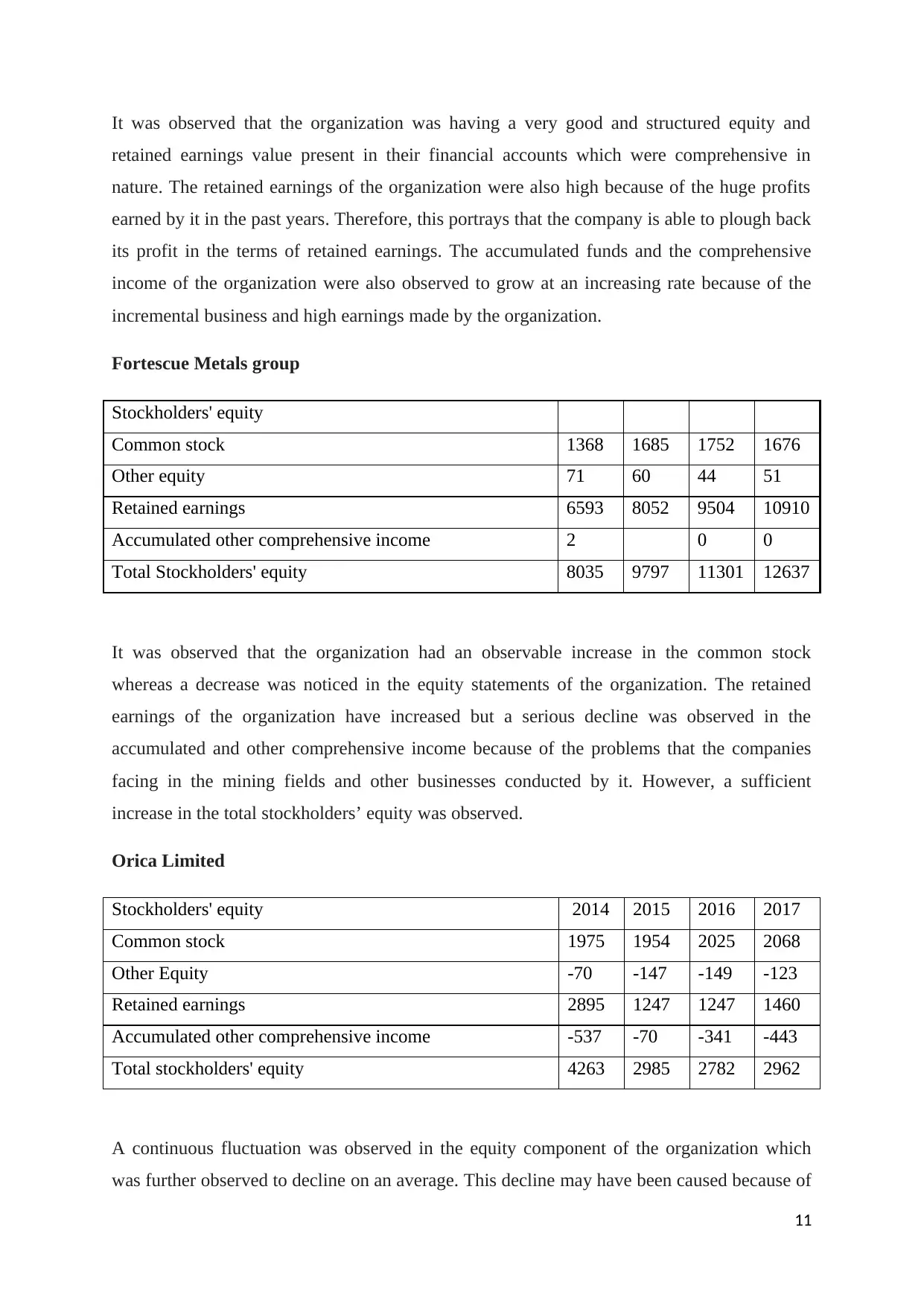
It was observed that the organization was having a very good and structured equity and
retained earnings value present in their financial accounts which were comprehensive in
nature. The retained earnings of the organization were also high because of the huge profits
earned by it in the past years. Therefore, this portrays that the company is able to plough back
its profit in the terms of retained earnings. The accumulated funds and the comprehensive
income of the organization were also observed to grow at an increasing rate because of the
incremental business and high earnings made by the organization.
Fortescue Metals group
Stockholders' equity
Common stock 1368 1685 1752 1676
Other equity 71 60 44 51
Retained earnings 6593 8052 9504 10910
Accumulated other comprehensive income 2 0 0
Total Stockholders' equity 8035 9797 11301 12637
It was observed that the organization had an observable increase in the common stock
whereas a decrease was noticed in the equity statements of the organization. The retained
earnings of the organization have increased but a serious decline was observed in the
accumulated and other comprehensive income because of the problems that the companies
facing in the mining fields and other businesses conducted by it. However, a sufficient
increase in the total stockholders’ equity was observed.
Orica Limited
Stockholders' equity 2014 2015 2016 2017
Common stock 1975 1954 2025 2068
Other Equity -70 -147 -149 -123
Retained earnings 2895 1247 1247 1460
Accumulated other comprehensive income -537 -70 -341 -443
Total stockholders' equity 4263 2985 2782 2962
A continuous fluctuation was observed in the equity component of the organization which
was further observed to decline on an average. This decline may have been caused because of
11
retained earnings value present in their financial accounts which were comprehensive in
nature. The retained earnings of the organization were also high because of the huge profits
earned by it in the past years. Therefore, this portrays that the company is able to plough back
its profit in the terms of retained earnings. The accumulated funds and the comprehensive
income of the organization were also observed to grow at an increasing rate because of the
incremental business and high earnings made by the organization.
Fortescue Metals group
Stockholders' equity
Common stock 1368 1685 1752 1676
Other equity 71 60 44 51
Retained earnings 6593 8052 9504 10910
Accumulated other comprehensive income 2 0 0
Total Stockholders' equity 8035 9797 11301 12637
It was observed that the organization had an observable increase in the common stock
whereas a decrease was noticed in the equity statements of the organization. The retained
earnings of the organization have increased but a serious decline was observed in the
accumulated and other comprehensive income because of the problems that the companies
facing in the mining fields and other businesses conducted by it. However, a sufficient
increase in the total stockholders’ equity was observed.
Orica Limited
Stockholders' equity 2014 2015 2016 2017
Common stock 1975 1954 2025 2068
Other Equity -70 -147 -149 -123
Retained earnings 2895 1247 1247 1460
Accumulated other comprehensive income -537 -70 -341 -443
Total stockholders' equity 4263 2985 2782 2962
A continuous fluctuation was observed in the equity component of the organization which
was further observed to decline on an average. This decline may have been caused because of
11
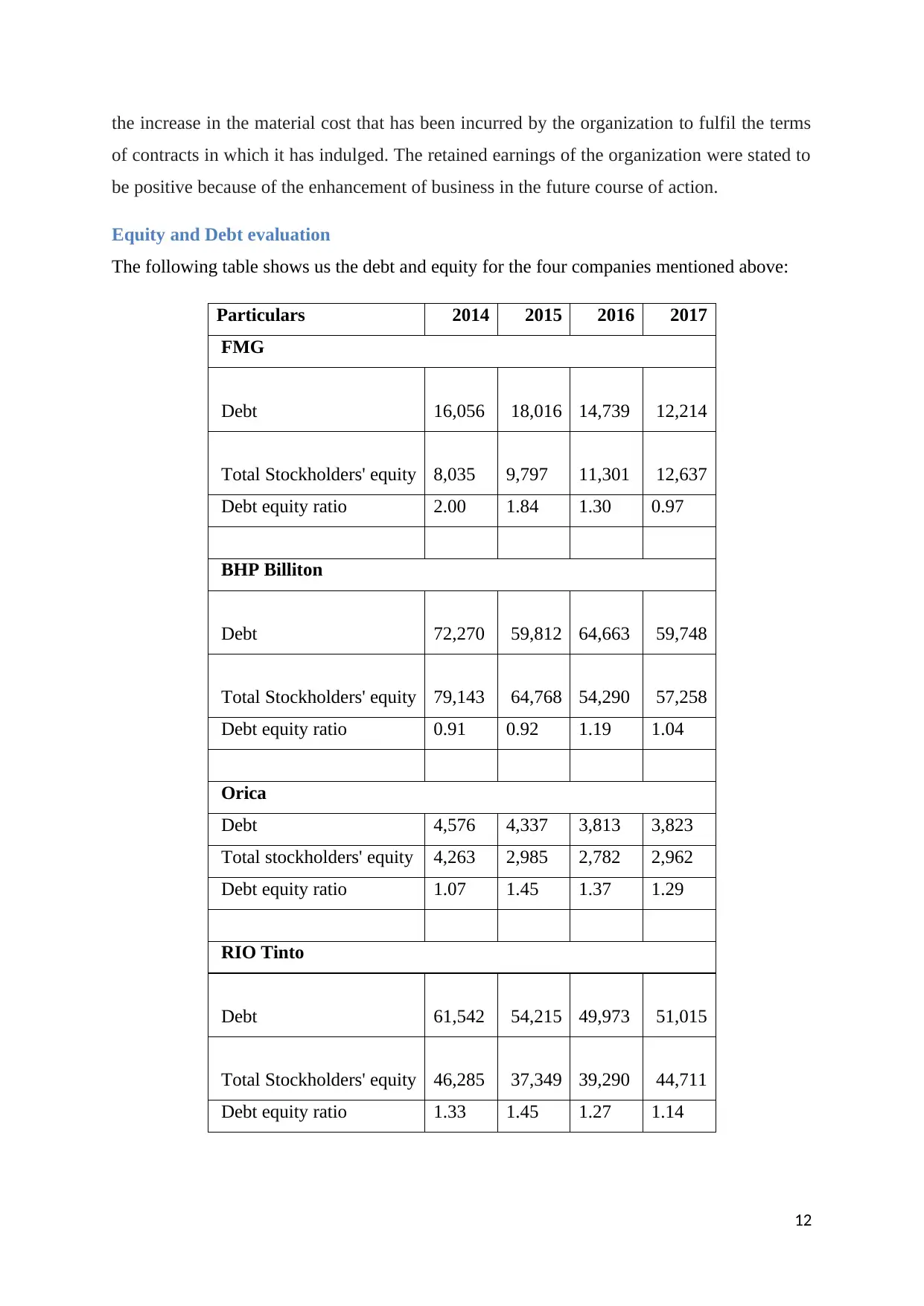
the increase in the material cost that has been incurred by the organization to fulfil the terms
of contracts in which it has indulged. The retained earnings of the organization were stated to
be positive because of the enhancement of business in the future course of action.
Equity and Debt evaluation
The following table shows us the debt and equity for the four companies mentioned above:
Particulars 2014 2015 2016 2017
FMG
Debt 16,056 18,016 14,739 12,214
Total Stockholders' equity 8,035 9,797 11,301 12,637
Debt equity ratio 2.00 1.84 1.30 0.97
BHP Billiton
Debt 72,270 59,812 64,663 59,748
Total Stockholders' equity 79,143 64,768 54,290 57,258
Debt equity ratio 0.91 0.92 1.19 1.04
Orica
Debt 4,576 4,337 3,813 3,823
Total stockholders' equity 4,263 2,985 2,782 2,962
Debt equity ratio 1.07 1.45 1.37 1.29
RIO Tinto
Debt 61,542 54,215 49,973 51,015
Total Stockholders' equity 46,285 37,349 39,290 44,711
Debt equity ratio 1.33 1.45 1.27 1.14
12
of contracts in which it has indulged. The retained earnings of the organization were stated to
be positive because of the enhancement of business in the future course of action.
Equity and Debt evaluation
The following table shows us the debt and equity for the four companies mentioned above:
Particulars 2014 2015 2016 2017
FMG
Debt 16,056 18,016 14,739 12,214
Total Stockholders' equity 8,035 9,797 11,301 12,637
Debt equity ratio 2.00 1.84 1.30 0.97
BHP Billiton
Debt 72,270 59,812 64,663 59,748
Total Stockholders' equity 79,143 64,768 54,290 57,258
Debt equity ratio 0.91 0.92 1.19 1.04
Orica
Debt 4,576 4,337 3,813 3,823
Total stockholders' equity 4,263 2,985 2,782 2,962
Debt equity ratio 1.07 1.45 1.37 1.29
RIO Tinto
Debt 61,542 54,215 49,973 51,015
Total Stockholders' equity 46,285 37,349 39,290 44,711
Debt equity ratio 1.33 1.45 1.27 1.14
12
⊘ This is a preview!⊘
Do you want full access?
Subscribe today to unlock all pages.

Trusted by 1+ million students worldwide
1 out of 16
Related Documents
Your All-in-One AI-Powered Toolkit for Academic Success.
+13062052269
info@desklib.com
Available 24*7 on WhatsApp / Email
![[object Object]](/_next/static/media/star-bottom.7253800d.svg)
Unlock your academic potential
Copyright © 2020–2025 A2Z Services. All Rights Reserved. Developed and managed by ZUCOL.




